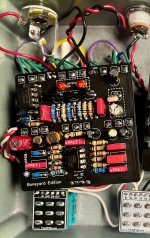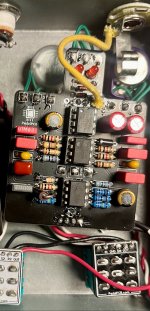Champagneperfume
Member
Greetings!
I built a 2-in-1 (signal chain flipper footswitch as well) pedal, the Delegate Boneyard Edition Compressor and the Greengage Overdrive. I get an obnoxious high pitch squeal when the Greengage/Plumes is on, goes away when off, goes away when both effects are engaged. The whistle kicks in when the pots on the Greengage pass about 70% rotation. Other than the gnarly whistle, it works like a charm.
I've read up on some other posts about electromagnetic interference noise coming from the charge pumps in each respective pedal as the culprit.
I chased through and around the Plumes/Greengage Overdrive with a Boss Looper, Rattlesnake Audio-probe, and a Scarlett audio interface into my MacBook...and the harsh squeal noise goes away ENTIRELY.
This noise only returns when I'm using an electric guitar (Fender Player Jaguar with stock pickups, I've also tried with a 2005 Mexican Telecaster with stock pickups and had the same result) that uses that previously mentioned set up. I've also tried it into a Vox AC-15 instead of the Scarlett audio interface and the results are basically identical.
I'm wondering if this an issue with the pickups and multiple unshielded wires? I can make the whistle go away for a minute if the pcb is in perfect position, but it's such a delicate spot and returns to the hellish screech very quickly. I ordered shielded wire so I'll be trying that as well.
Anyone got any clues or ideas?
I was planning on experimenting with pot values, measuring the Ohms at the spot where the noise kicks in and adjust it accordingly. That and the shielded wires.



I built a 2-in-1 (signal chain flipper footswitch as well) pedal, the Delegate Boneyard Edition Compressor and the Greengage Overdrive. I get an obnoxious high pitch squeal when the Greengage/Plumes is on, goes away when off, goes away when both effects are engaged. The whistle kicks in when the pots on the Greengage pass about 70% rotation. Other than the gnarly whistle, it works like a charm.
I've read up on some other posts about electromagnetic interference noise coming from the charge pumps in each respective pedal as the culprit.
I chased through and around the Plumes/Greengage Overdrive with a Boss Looper, Rattlesnake Audio-probe, and a Scarlett audio interface into my MacBook...and the harsh squeal noise goes away ENTIRELY.
This noise only returns when I'm using an electric guitar (Fender Player Jaguar with stock pickups, I've also tried with a 2005 Mexican Telecaster with stock pickups and had the same result) that uses that previously mentioned set up. I've also tried it into a Vox AC-15 instead of the Scarlett audio interface and the results are basically identical.
I'm wondering if this an issue with the pickups and multiple unshielded wires? I can make the whistle go away for a minute if the pcb is in perfect position, but it's such a delicate spot and returns to the hellish screech very quickly. I ordered shielded wire so I'll be trying that as well.
Anyone got any clues or ideas?
I was planning on experimenting with pot values, measuring the Ohms at the spot where the noise kicks in and adjust it accordingly. That and the shielded wires.





